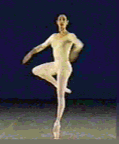.gif)
Spotting (dance technique)
Encyclopedia

Dance
Dance is an art form that generally refers to movement of the body, usually rhythmic and to music, used as a form of expression, social interaction or presented in a spiritual or performance setting....
turns. The goal of spotting is to attain a constant orientation of the dancer's head and eyes, to the extent possible, in order to enhance the dancer's control and prevent dizziness.
As a dancer turns, spotting is performed by rotating the body and head at different rates. While the body rotates smoothly at a relatively constant speed, the head periodically rotates much faster and then stops, so as to fix the dancer's gaze on a single location (the spotting point, or simply the spot). Dancers will sometimes focus on an actual visual spot if one is available (e.g., a light or other object), but if no suitable object is available they will attempt to end each head rotation in a consistent orientation. The spotting point may be another dancer, in which case the spot may move.
Usage
Spotting is advantageous for dancers in several ways:- It prevents dizzinessDizzinessDizziness refers to an impairment in spatial perception and stability. The term is somewhat imprecise. It can be used to mean vertigo, presyncope, disequilibrium, or a non-specific feeling such as giddiness or foolishness....
by providing a fixed focus for the eyes. - The fixed focus also helps the dancer control balanceBalance (ability)In biomechanics, balance is an ability to maintain the center of gravity of a body within the base of support with minimal postural sway. When exercising the ability to balance, one is said to be balancing....
. - It helps the dancer control the direction of travel during traveling turns such as chaînés and piqués.
Spotting technique is employed for many types of turns, including pirouettes and chaînés. It is deliberately avoided in some types of turns, however. For example, adagio turns — in which the aesthetics are intended to convey serenity and calm — would be disturbed by the abrupt head movements of spotting. Turns in adagio style include turns in arabesque
Arabesque (ballet position)
In classical ballet, the term arabesque In classical ballet, the term arabesque In classical ballet, the term arabesque (aa-rah-besk; literally, "in Arabic fashion". Specifically, "arabesque" references an architectural design term that describes and is a spiral...
or attitude positions.
In some cases multiple spots may be used during a turn. For example, during a Salsa
Salsa (dance)
Salsa is a syncretic dance form with origins in Cuba as the meeting point of Spanish and African cultures.Salsa is normally a partner dance, although there are recognized solo forms such as solo dancing "suelta" and "Rueda de Casino" where multiple couples exchange partners in a circle...
cross-body lead with inside turn, the lady spots away from her partner to control travel and then spots on her partner to control the stop of rotation.

